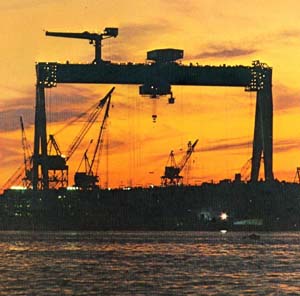
The yard's signature "Goliath" crane
Click on the photos for a larger version; click on links in the text for more infomation.


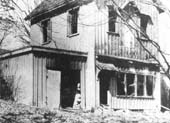 Thomas Augustus Watson is best known as Alexander
Graham Bell's assistant, but to shipbuilders he is important
for an entirely different reason.
Thomas Augustus Watson is best known as Alexander
Graham Bell's assistant, but to shipbuilders he is important
for an entirely different reason.
Watson left the Bell Co. in 1881, then spent a year traveling, and two
years farming at East Braintree, Massachusetts. In 1884 he founded the
Fore River Engine Company, initially located in this small house in East
Braintree, near the Fore River. This tiny business, with only one
employee, was the humble start of what would soon become one of the
nation's largest shipyards.
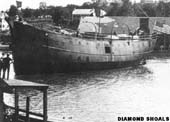 In 1900 the company launched the lightship Diamond
Shoals (left), the first all-steel vessel built on Boston's South Shore,
and the destroyer USS Lawrence, the yard's first naval contract.
In 1900 the company launched the lightship Diamond
Shoals (left), the first all-steel vessel built on Boston's South Shore,
and the destroyer USS Lawrence, the yard's first naval contract.
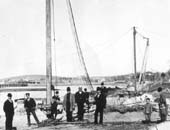 Another major event in 1900 was the groundbreaking for the company's new
shipyard, two miles
downriver from the old site.
The new location, in Quincy, MA, was a good
location for a shipyard - near the
major seaport of Boston, convenient to rail and sea transportation,
possessing both a sheltered, riverside location, and deepwater access to
the ocean, and with plenty of space to expand. One drawback was the
wooden bridge across the river's mouth, seen in this view of the
groundbreaking ceremony, which kept large ships out of the river. Watson
prevailed upon the local governments to fund a new bridge - and they hired
him to build it!
Another major event in 1900 was the groundbreaking for the company's new
shipyard, two miles
downriver from the old site.
The new location, in Quincy, MA, was a good
location for a shipyard - near the
major seaport of Boston, convenient to rail and sea transportation,
possessing both a sheltered, riverside location, and deepwater access to
the ocean, and with plenty of space to expand. One drawback was the
wooden bridge across the river's mouth, seen in this view of the
groundbreaking ceremony, which kept large ships out of the river. Watson
prevailed upon the local governments to fund a new bridge - and they hired
him to build it!

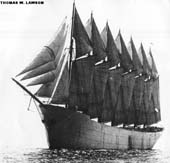 The view at left shows the company's facilities circa 1902. In this year the
cruiser Des Moines was launched from the new yard; she was the
largest vessel yet built by the company. Another 1902 launching was the
giant seven-masted schooner Thomas W. Lawson, the only ship
of her type ever constructed.
By this time the new yard, now known as the
Fore River Ship & Engine Co., was a busy and growing enterprise, soon to
have an even bigger role in the shipbuilding industry.
The view at left shows the company's facilities circa 1902. In this year the
cruiser Des Moines was launched from the new yard; she was the
largest vessel yet built by the company. Another 1902 launching was the
giant seven-masted schooner Thomas W. Lawson, the only ship
of her type ever constructed.
By this time the new yard, now known as the
Fore River Ship & Engine Co., was a busy and growing enterprise, soon to
have an even bigger role in the shipbuilding industry.
 In the years leading up to WWI, the Fore River yard constructed a wide
variety of ships, including cruisers, destroyers, submarines, four
battleships, and numerous merchant ships.
In the years leading up to WWI, the Fore River yard constructed a wide
variety of ships, including cruisers, destroyers, submarines, four
battleships, and numerous merchant ships.
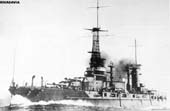 To accommodate these contracts the yard continued to expand; at left is a
view of the yard circa 1910, apparently from the large crane on the
fitting-out pier. One of the four battleship contracts in the prewar
years was for Rivadavia, built for Argentina (at right); she was
the first Fore River vessel built for a foreign power. Bethlehem Steel
had the contract to supply the steel for this vessel, and many others
built at the yard. Due to concerns about Fore River's ability to
complete the Rivadavia on budget, Bethlehem Steel purchased the
shipyard in 1913, thereby protecting their interest in the contract, and
securing a greater role in the shipbuilding industry.
To accommodate these contracts the yard continued to expand; at left is a
view of the yard circa 1910, apparently from the large crane on the
fitting-out pier. One of the four battleship contracts in the prewar
years was for Rivadavia, built for Argentina (at right); she was
the first Fore River vessel built for a foreign power. Bethlehem Steel
had the contract to supply the steel for this vessel, and many others
built at the yard. Due to concerns about Fore River's ability to
complete the Rivadavia on budget, Bethlehem Steel purchased the
shipyard in 1913, thereby protecting their interest in the contract, and
securing a greater role in the shipbuilding industry.
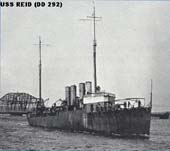
 Now known as Bethlehem Fore River, and later as Bethlehem Quincy, Watson's
yard continued to grow and prosper. As war clouds gathered in Europe, the
need for ships - especially naval vessels - increased. Bethlehem
constructed an additional shipyard in the nearby Squantum section of
Quincy, intended specificially for mass-production of destroyers, while
also expanding the Fore River yard; wartime employment reached 15,000. At
right is a view of the Fore River yard in early 1919, while WWI
construction programs were still ongoing; at least five "flush deck"
destroyers are visible along the waterfront. Together, the Fore River and
Squantum yards turned in an admirable performance during the war, building
18 destroyers, 10 submarines, and 6 merchant ships in 1918 alone. In all,
the yards built 71 destroyers during the war - more than the total output
of all other US shipyards combined! One of the war-built destroyers was
USS Reid (DD 292) (at left, clearing the Fore River bridge), built
in a record-setting time of 45 1/2 days. Following WWI the Squantum yard
was closed, later becoming part of a Naval Air Station; decades later the
site was redeveloped as a residential community.
Now known as Bethlehem Fore River, and later as Bethlehem Quincy, Watson's
yard continued to grow and prosper. As war clouds gathered in Europe, the
need for ships - especially naval vessels - increased. Bethlehem
constructed an additional shipyard in the nearby Squantum section of
Quincy, intended specificially for mass-production of destroyers, while
also expanding the Fore River yard; wartime employment reached 15,000. At
right is a view of the Fore River yard in early 1919, while WWI
construction programs were still ongoing; at least five "flush deck"
destroyers are visible along the waterfront. Together, the Fore River and
Squantum yards turned in an admirable performance during the war, building
18 destroyers, 10 submarines, and 6 merchant ships in 1918 alone. In all,
the yards built 71 destroyers during the war - more than the total output
of all other US shipyards combined! One of the war-built destroyers was
USS Reid (DD 292) (at left, clearing the Fore River bridge), built
in a record-setting time of 45 1/2 days. Following WWI the Squantum yard
was closed, later becoming part of a Naval Air Station; decades later the
site was redeveloped as a residential community.
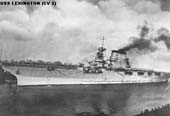 Between the World Wars Quincy maintained a steady stream of merchant
vessels and warships - cruisers, submarines, destroyers, and aircraft
carriers. One of the largest and most important ships of the 'tween-wars
years was the big aircraft carrier USS Lexington (CV 2), the "Queen
of the Flattops", converted from a cancelled battlecruiser and delivered
in 1927. As the first non-experimental carriers in the US fleet, she and
her sister Saratoga played a vital role in building the US carrier
forces that were so vital to naval warfare during WWII. Lexington
was a source of great pride for Quincy shipbuilders, and her loss early in
WWII was deeply felt at the yard.
Between the World Wars Quincy maintained a steady stream of merchant
vessels and warships - cruisers, submarines, destroyers, and aircraft
carriers. One of the largest and most important ships of the 'tween-wars
years was the big aircraft carrier USS Lexington (CV 2), the "Queen
of the Flattops", converted from a cancelled battlecruiser and delivered
in 1927. As the first non-experimental carriers in the US fleet, she and
her sister Saratoga played a vital role in building the US carrier
forces that were so vital to naval warfare during WWII. Lexington
was a source of great pride for Quincy shipbuilders, and her loss early in
WWII was deeply felt at the yard.
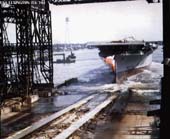
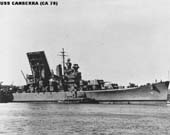 Starting in the late 1930's Quincy once again stepped up production to
meet the wartime challenge. By 1941 employment had already reached
17,000, and facilities were being rapidly expanded to accommodate growing
shipbuilding requirements. The yard turned out numerous aircraft
carriers, cruisers, destroyers, and the battleship USS
Massachusetts during the war. Aircraft carriers included USS
Lexington (CV 16) (at left, launching), named in honor of the
previous carrier Lexington, and the cruiser USS Canberra (CA
70) (at right, clearing the new Fore River bridge), honoring an Australian
cruiser sunk while operating with US forces early in the war.
Starting in the late 1930's Quincy once again stepped up production to
meet the wartime challenge. By 1941 employment had already reached
17,000, and facilities were being rapidly expanded to accommodate growing
shipbuilding requirements. The yard turned out numerous aircraft
carriers, cruisers, destroyers, and the battleship USS
Massachusetts during the war. Aircraft carriers included USS
Lexington (CV 16) (at left, launching), named in honor of the
previous carrier Lexington, and the cruiser USS Canberra (CA
70) (at right, clearing the new Fore River bridge), honoring an Australian
cruiser sunk while operating with US forces early in the war.
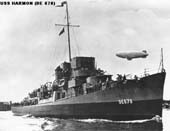 Once again an additional mass-production yard was needed to meet wartime
shipbuilding needs. This yard, located in nearby Hingham, built destroyer
escorts and landing ships (LST, LCI(L)) in great numbers. These smaller,
relatively simple ships played a vital role in the US victory, and were
built in record time. One DE was launched just 23 days after keel-laying,
and in one 50-hour span a total of 5 LSTs were delivered. Combined
employment at the Hingham and Quincy yards reached 32,000 - more than
double the WWI peak. The Hingham yard closed down after the war, and was
eventually sold off and used for various industrial purposes. The Hingham
shipyard property is now scheduled to be redeveloped as a residential
community.
Once again an additional mass-production yard was needed to meet wartime
shipbuilding needs. This yard, located in nearby Hingham, built destroyer
escorts and landing ships (LST, LCI(L)) in great numbers. These smaller,
relatively simple ships played a vital role in the US victory, and were
built in record time. One DE was launched just 23 days after keel-laying,
and in one 50-hour span a total of 5 LSTs were delivered. Combined
employment at the Hingham and Quincy yards reached 32,000 - more than
double the WWI peak. The Hingham yard closed down after the war, and was
eventually sold off and used for various industrial purposes. The Hingham
shipyard property is now scheduled to be redeveloped as a residential
community.
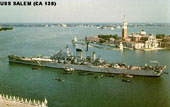
 The postwar years saw a wide variety of shipbuilding at Quincy.
Naval shipbuilding ranged from ships ordered under the wartime
shipbuilding programs, such as the cruiser
USS Salem (CA 139)
(left), to the hi-tech nuclear-powered missile ships USS
Bainbridge (DLGN 25) and USS Long Beach (CGN 9) (right), the
world's first nuclear powered surface combatant. Other
naval construction included destroyers, frigates, and a tanker.
Commercial projects included the liner Independence (completed in
1950 and still in service today), and the supertanker Manhattan,
famous for her voyage through the Northwest Passage. Unfortunately, the
prosperity could not last; Bethlehem closed the yard in 1963.
The postwar years saw a wide variety of shipbuilding at Quincy.
Naval shipbuilding ranged from ships ordered under the wartime
shipbuilding programs, such as the cruiser
USS Salem (CA 139)
(left), to the hi-tech nuclear-powered missile ships USS
Bainbridge (DLGN 25) and USS Long Beach (CGN 9) (right), the
world's first nuclear powered surface combatant. Other
naval construction included destroyers, frigates, and a tanker.
Commercial projects included the liner Independence (completed in
1950 and still in service today), and the supertanker Manhattan,
famous for her voyage through the Northwest Passage. Unfortunately, the
prosperity could not last; Bethlehem closed the yard in 1963.
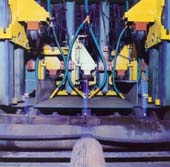 The Quincy shipyard was purchased by General Dynamics Corporation in 1964,
becoming that company's Quincy Shipbuilding Division, and a "sister"
division to Electric Boat. Within a few years General Dynamics invested in
major modernizations of the shipyard.
The Quincy shipyard was purchased by General Dynamics Corporation in 1964,
becoming that company's Quincy Shipbuilding Division, and a "sister"
division to Electric Boat. Within a few years General Dynamics invested in
major modernizations of the shipyard.
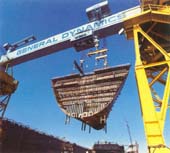 Modernizaton included replacement of the conventional sliding ways with
modern
construction basins, implementation of a highly automated production
process, and extensive use of "pre-outfit" construction techniques. At
left is an automated plate stiffener, part of the semi-automated steel
fabrication process. At right, the 1,200 ton capacity "Goliath" crane
lowers the entire bow section of a LNG tanker into place. Preoutift or
"modular" construction allows entire pieces of the ship to be built and
outfitted with all their equipment in a shop or assembly area away from
the building slip, where work can be done most efficiently. The pieces,
weighing anything from 150 tons to over 1,000 tons, are then installed on
the ship by cranes. The 1,200 ton Goliath crane, part of General
Dynamics' modernization of the facility, and largest shipbuilding crane on
the continent, was a key to the use of very large preoutfit units, such as
entire deckhouses, bows, and sterns.
Modernizaton included replacement of the conventional sliding ways with
modern
construction basins, implementation of a highly automated production
process, and extensive use of "pre-outfit" construction techniques. At
left is an automated plate stiffener, part of the semi-automated steel
fabrication process. At right, the 1,200 ton capacity "Goliath" crane
lowers the entire bow section of a LNG tanker into place. Preoutift or
"modular" construction allows entire pieces of the ship to be built and
outfitted with all their equipment in a shop or assembly area away from
the building slip, where work can be done most efficiently. The pieces,
weighing anything from 150 tons to over 1,000 tons, are then installed on
the ship by cranes. The 1,200 ton Goliath crane, part of General
Dynamics' modernization of the facility, and largest shipbuilding crane on
the continent, was a key to the use of very large preoutfit units, such as
entire deckhouses, bows, and sterns.
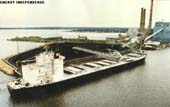 Under General Dynamics ownership, Quincy concentrated on large merchant
and naval vessels, well suited to semi-automated and preoutfit
construction techniques.
Under General Dynamics ownership, Quincy concentrated on large merchant
and naval vessels, well suited to semi-automated and preoutfit
construction techniques.
 Naval construction included replenishment oilers, ammunition ships,
submarine tenders, and amphibious ships such as USS Mount Vernon
(LSD 39), at left. Quincy also constructed several nuclear powered
submarines before that work was consolidated at General Dynamics' Electric
Boat Division. Merchant construction included large, but relatively
complex ships, such as SeaBee barge carriers, roll-on/roll-off vehicle
ships, and the innovative coal-fired self-unloading collier Energy
Independence (right), designed to haul coal to New England power
plants. Quincy also did extensive overhaul, modernization, and conversion
work for both military and commercial customers, including the complete
reconstruction of the cable layer USNS Neptune (T-ARC 2), and the
rebuilding of the tanker Overseas Boston.
Naval construction included replenishment oilers, ammunition ships,
submarine tenders, and amphibious ships such as USS Mount Vernon
(LSD 39), at left. Quincy also constructed several nuclear powered
submarines before that work was consolidated at General Dynamics' Electric
Boat Division. Merchant construction included large, but relatively
complex ships, such as SeaBee barge carriers, roll-on/roll-off vehicle
ships, and the innovative coal-fired self-unloading collier Energy
Independence (right), designed to haul coal to New England power
plants. Quincy also did extensive overhaul, modernization, and conversion
work for both military and commercial customers, including the complete
reconstruction of the cable layer USNS Neptune (T-ARC 2), and the
rebuilding of the tanker Overseas Boston.
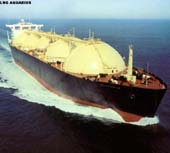
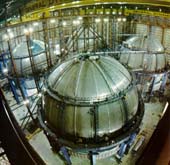 The major constructon program at Quincy from the mid-1970's to the early
1980's was the construction of 10 liquified natural gas (LNG) tankers.
These massive ships, 936 feet long and displacing as much as a large
aircraft carrier, transported 125,000 cubic meters of LNG in five 120 foot
diameter cargo spheres. Preoutfit and "modular" construction were
extensively employed in building the LNG tankers. The bow, stern,
midbody, and deckhouse were constructed separately, then joined together
at various stages of assembly. The huge, 750-ton cargo spheres were
constructed in a specialized facility at Charleston, South Carolina
(right), brought to Quincy on a special barge, and loaded aboard with the
Goliath crane. The complex compressor and cryogenic piping modules, and
the sphere covers, were constructed at Quincy and loaded aboard after the
spheres had been installed. The Quincybuilt LNG tankers are regarded as
highly successful ships, and remain in service today.
The major constructon program at Quincy from the mid-1970's to the early
1980's was the construction of 10 liquified natural gas (LNG) tankers.
These massive ships, 936 feet long and displacing as much as a large
aircraft carrier, transported 125,000 cubic meters of LNG in five 120 foot
diameter cargo spheres. Preoutfit and "modular" construction were
extensively employed in building the LNG tankers. The bow, stern,
midbody, and deckhouse were constructed separately, then joined together
at various stages of assembly. The huge, 750-ton cargo spheres were
constructed in a specialized facility at Charleston, South Carolina
(right), brought to Quincy on a special barge, and loaded aboard with the
Goliath crane. The complex compressor and cryogenic piping modules, and
the sphere covers, were constructed at Quincy and loaded aboard after the
spheres had been installed. The Quincybuilt LNG tankers are regarded as
highly successful ships, and remain in service today.
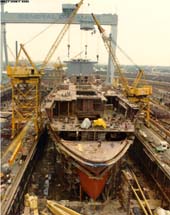
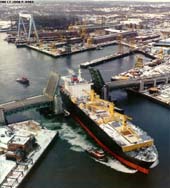 Quincy's major project during the early- and mid-1980's was the
construction of five Maritime Prepositioning Ships (MPS) for
the US Navy. Each of these 42,000
ton ships was designed to carry all the equipment and supplies need to
support 4,000 Marines in combat for 30 days. The cargo included not only
the Marines' vehicles, but all the equipment, supplies, stores, spare
parts, munitions, fuels, and water the troops would need. To accommodate
this cargo, each ship featured 150,000 square feet of vehicle decks, over
1.6 million gallons of cargo tank capacity (200,000 gallons gasoline,
540,000 gallons diesel fuel, 855,000 gallons jet fuel, 82,000 gallons
potable water), stowage for 433 drums of kerosene and lube oil, and space
for 490 standard cargo containers, which provided 101,000 cubic feet for
general cargo, 18,000 cubic feet for refrigerated cargo, and 230,000 cubic
feet of munitions stowage. In addition to carrying this impressive
loadout, the ships would have to put all the cargo ashore while anchored
two miles offshore in 50-knot winds, a three-knot current, and five-foot
seas. Accordingly, the ships were equipped with a stern ramp for
amphibious vehicles, five 39-ton cranes, two LCM(8) landing craft, 11
lighters, a floating pipeline system, and a special anchoring system.
Quincy's major project during the early- and mid-1980's was the
construction of five Maritime Prepositioning Ships (MPS) for
the US Navy. Each of these 42,000
ton ships was designed to carry all the equipment and supplies need to
support 4,000 Marines in combat for 30 days. The cargo included not only
the Marines' vehicles, but all the equipment, supplies, stores, spare
parts, munitions, fuels, and water the troops would need. To accommodate
this cargo, each ship featured 150,000 square feet of vehicle decks, over
1.6 million gallons of cargo tank capacity (200,000 gallons gasoline,
540,000 gallons diesel fuel, 855,000 gallons jet fuel, 82,000 gallons
potable water), stowage for 433 drums of kerosene and lube oil, and space
for 490 standard cargo containers, which provided 101,000 cubic feet for
general cargo, 18,000 cubic feet for refrigerated cargo, and 230,000 cubic
feet of munitions stowage. In addition to carrying this impressive
loadout, the ships would have to put all the cargo ashore while anchored
two miles offshore in 50-knot winds, a three-knot current, and five-foot
seas. Accordingly, the ships were equipped with a stern ramp for
amphibious vehicles, five 39-ton cranes, two LCM(8) landing craft, 11
lighters, a floating pipeline system, and a special anchoring system.
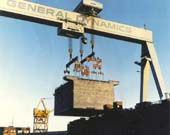 Construction of these ships, although simpler than the LNG tankers,
included one very notable feature. The massive deckhouses were
constructed and outfitted off-ship, and were lifted in place by the
Goliath crane. Weighing in at an incredible 1,120 tons, the MPS
deckhouses were the heaviest shipyard lifts ever accomplished in the US.
This heavyweight lift record still stands today. The five MPSs were
delivered in 1985-86, and are stationed in key locations around the world,
fully loaded and ready to sail for any trouble spot.
Construction of these ships, although simpler than the LNG tankers,
included one very notable feature. The massive deckhouses were
constructed and outfitted off-ship, and were lifted in place by the
Goliath crane. Weighing in at an incredible 1,120 tons, the MPS
deckhouses were the heaviest shipyard lifts ever accomplished in the US.
This heavyweight lift record still stands today. The five MPSs were
delivered in 1985-86, and are stationed in key locations around the world,
fully loaded and ready to sail for any trouble spot.
 With the completion of the MPS contract in 1986, Quincy's future looked
bleak; there were simply too many shipyards and too few new ship orders.
When Quincy failed to land contracts for U.S. Lines container ships and
new survey ships for the Navy, the shipyard was doomed. The yard was
closed in 1986; the remaining employees were laid off or retired, and the
shipyard lay idle for the first time in decades. At left is a view of the
yard, taken in 1981 as the LNG program was coming to a close, showing the
facility in essentially its final form. The wet basin and two
construction basins are at left; the three assembly basins and the Goliath
crane at center, and the fitting out piers at right.
With the completion of the MPS contract in 1986, Quincy's future looked
bleak; there were simply too many shipyards and too few new ship orders.
When Quincy failed to land contracts for U.S. Lines container ships and
new survey ships for the Navy, the shipyard was doomed. The yard was
closed in 1986; the remaining employees were laid off or retired, and the
shipyard lay idle for the first time in decades. At left is a view of the
yard, taken in 1981 as the LNG program was coming to a close, showing the
facility in essentially its final form. The wet basin and two
construction basins are at left; the three assembly basins and the Goliath
crane at center, and the fitting out piers at right.
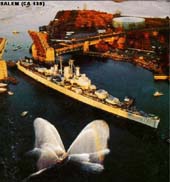 Following the closure the yard lay dormant for many years. Equipment was
sold off; parts of the facility were used for staging areas for public
works construction projects. A ship scrapping operation operated briefly
at one end of the shipyard, but soon closed down. There have been many
efforts to re-open and modernize the shipyard, but to date none has come
to fruition.
Following the closure the yard lay dormant for many years. Equipment was
sold off; parts of the facility were used for staging areas for public
works construction projects. A ship scrapping operation operated briefly
at one end of the shipyard, but soon closed down. There have been many
efforts to re-open and modernize the shipyard, but to date none has come
to fruition.
In 1994 the Quincybuilt cruiser Salem (CA
139) returned home to the Quincy yard, becoming the centerpiece of
the United States Naval & Shipbuilding Museum.
Today Salem is berthed at the same fitting-out pier where she was
completed over 50 years ago.

| Haze Gray & Underway | |||||
| Naval History Info Center | US Warship Histories - DANFS | World Navies Today | |||
| Photo Galleries | Shipbuilding | Navsource Photos | |||
| HG&UW Home | Contact Info | About the Site | Web Links | FAQs | Back |